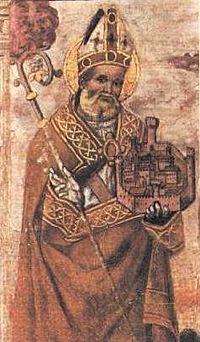| Revision as of 21:54, 1 January 2012 editSer Amantio di Nicolao (talk | contribs)Autopatrolled, Administrators6,317,302 edits →External links: add category using AWB← Previous edit | Revision as of 07:51, 16 May 2012 edit undoEmausBot (talk | contribs)Bots, Template editors2,862,716 editsm r2.7.2+) (Robot: Adding ca:Ubald de GubbioNext edit → | ||
| Line 83: | Line 83: | ||
| ] | ] | ||
| ] | |||
| ] | ] | ||
| ] | ] | ||
Revision as of 07:51, 16 May 2012
| Saint Ubaldo of Gubbio | |
|---|---|
 | |
| Bishop of Gubbio | |
| Born | ca. 1084 Gubbio, Italy |
| Died | 1160 Gubbio, Italy |
| Venerated in | Roman Catholic Church |
| Canonized | 4 March 1192 by Pope Celestine III |
| Major shrine | Duomo, Gubbio, Italy |
| Feast | May 16 |
| Attributes | Bishop giving a blessing as angels carry his crozier; bishop delivering a blessing while a devil flees from it; holding a scale model of Gubbio |
| Patronage | Gubbio, Italy; against demoniac possession; migraine, neuralgia, sick children; autistics; people suffering from obsessive compulsive disorder |
Ubald of Gubbio (Template:Lang-it; Template:Lang-la; Template:Lang-fr; ca. 1084–1160) was a medieval bishop of Gubbio, in Umbria, today venerated as a saint by the Catholic Church. Saint Ubaldo Day is still celebrated at Gubbio in his honor, as well as at Jessup, Pennsylvania.
Life
Born Ubaldo Baldassini of noble parents at Gubbio, Ubald lost his father while still very young. He was educated by the prior of the cathedral church of his native city, where he also became a canon regular. Saint Sperandia was a relative of Ubald.
He felt a vocation to become a monk, and entered to the Monastery of St. Secondo in the same city, where he remained for some years. Recalled by his bishop, he returned to the cathedral monastery, where he was made prior. Having heard that at Vienna Blessed Peter de Honestis some years before had established a very fervent community of canons regular, to whom he had given special statutes which had been approved by Paschal II, Ubald went there, remaining with his brother canons for three months, to learn the details and the practice of their rules, wishing to introduce them among his own canons of Gubbio.
This he did at his return. He earned a reputation for piety, poverty (for all his rich patrimony he had given to the poor and to the restoration of monasteries), humility, mortification, meekness, and fervour, and the fame of his holiness spread in the country, and several bishoprics were offered to him, but he refused them all.
Ubaldo is said to have prevented Frederick Barbarossa from sacking Gubbio as the emperor had sacked Spoleto in 1155.
However, the episcopal See of Gubbio becoming vacant, he was sent, with some clerics, by the population to ask for a new bishop from Honorius II who, having consecrated him, sent him back to Gubbio. To his people he became a perfect pattern of all Christian virtues, and a powerful protector in all their spiritual and temporal needs.
He died after a long and painful illness of two years.
Veneration

Numerous miracles were attributed to him during his life and after his death. At the solicitation of Bishop Bentivoglio Pope Celestine III canonized him in 1192. His power, as we read in the Office for his feast, is chiefly manifested over the evil spirits, and the faithful are instructed to have recourse to him "contra omnes diabolicas nequitias".
The life of the saint was written by Blessed Theobaldus (Theobald, Teobaldo), his immediate successor in the episcopal see, and from this source is derived all the information given by his numerous biographers. The body of Ubaldo, which had at first been buried in the cathedral church by the Bishops of Perugia and Cagli, at the time of his canonization was found flexible and incorrupt, and was then placed in a small oratory on the top of the hill overlooking the city, where in 1508, at the wish of the Duke of Urbino, the canons regular built a church, frequented by numerous pilgrims, who come to visit the relics.
The devotion to the saint is very popular throughout Umbria, but especially at Gubbio, where in every family at least one member is called Ubaldo. The feast of their patron saint is celebrated by the inhabitants of the country round with great solemnity, there being religious and civil processions which call to mind the famous festivities of the Middle Ages in Italy.
The Basilica of Sant' Ubaldo, with a nave and four aisles, is a sanctuary outside the city. Noteworthy are the marble altar and the great windows with episodes of the life of Ubaldo. The finely sculpted portals and the fragmentary frescoes give a hint of the magnificent 15th century decoration once boasted by the basilica.
Outside of Italy, a finger relic of Ubald is venerated in the Saint-Theobald collegiate church of Thann, Haut-Rhin (France).
References
External links
- UBALDO BALDASSINI Citizen, Bishop and Patron of Gubbio on Associazione Eugubini nel Mondo
- St. Ubaldus at the Catholic Encyclopedia
- Ubaldus Baldassini in the Patron Saint Index
- Template:It icon Sant' Ubaldo: Vescovo di Gubbio e Protettore di Thann
- St. Ubaldo Day in Jessup, PA on St. Ubaldo Society website
![]() This article incorporates text from a publication now in the public domain: Herbermann, Charles, ed. (1913). Catholic Encyclopedia. New York: Robert Appleton Company.
This article incorporates text from a publication now in the public domain: Herbermann, Charles, ed. (1913). Catholic Encyclopedia. New York: Robert Appleton Company. {{cite encyclopedia}}: Missing or empty |title= (help)